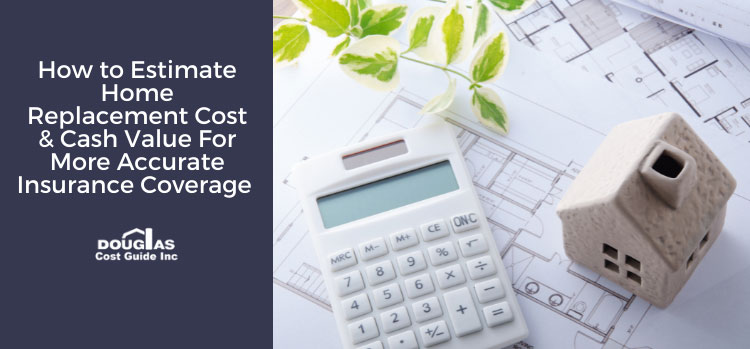When property owners select home insurance coverage, one of the most critical decisions involves designing a policy that deals with replacement cost or actual cash value. These items routinely confuse homeowners, and a misstep can lead to insurance coverage that may leave people with unanticipated out-of-pocket expenses.
Replacement cost and actual cash value involve home insurance reimbursement amounts. A smartly calculated policy includes a replacement cost estimate that covers all construction and peripheral expenses, minus any deductible. By contrast, actual cash value estimates consider items such as depreciation. Although insurance coverage focused on actual cash value may not necessarily deliver a full reimbursement, it has other advantages. By leveraging the Douglas Residential Cost Guides, homeowners can make informed decisions about insurance coverage based on actual cash value or replacement cost.
Estimating Home Replacement Cost with Douglas Cost Guides
Home insurance policies based on replacement cost require a baseline figure that all parties can agree upon. Insurance companies and adjusters widely agree that the Douglas Cost Guides provide industry-leading replacement cost estimates because all the unique elements of a given residence are included. Sometimes called the “rebuild cost,” estimates must account for the current-day price of materials, labour, permits, and other wide-reaching factors.
One of the common missteps homeowners make involves basing replacement cost coverage on the purchase price or market value. Although that connection may seem logical on the surface, purchase price, fair market value, and replacement costs have little in common.
Like other types of property, age and deterioration tend to reduce the value of a dwelling. But that reality has no bearing on the fact the price of rebuilding generally rises year after year. The market value of an older home can be light-years away from the cost of repairs or replacement. Fortunately, property owners who use the Douglas Cost Guides have access to accurate information to base insurance coverage on that won’t leave them reaching into their pockets.
Estimating the Actual Cash Value with Douglas Cost Guides
One of the driving reasons people select home insurance based on actual cash value usually involves lower premiums. Insurance coverage tasked with paying out only actual cash value is not necessarily on the hook for full replacement costs.
The common methodology involved in actual cash value coverage considers depreciation as a factor. For example, a roof with an expected 25-year lifespan may lose 1 percent of actual cash value insurance coverage each year. If that roof suffers severe weather damage during year 20, the homeowners may receive reimbursement for 5 percent of the total cost. That type of insurance coverage may make perfect sense for certain homeowners. However, making an informed decision means knowing the actual cash value of the roof, foundation, semi-detached home, and how much it would cost to rebuild.
Everyday people can calculate insurance coverage needs by inputting their home’s information into the Douglas Cost Guides, which is available to everyone online, for a nominal fee. With accurate and up-to-date replacement cost and actual cash value estimates in hand, homeowners can make the insurance coverage choices that serve their interests.
Are you looking to estimate the actual cash value of your home? Leverage the Douglas Cost Guides today to get an accurate estimate.

